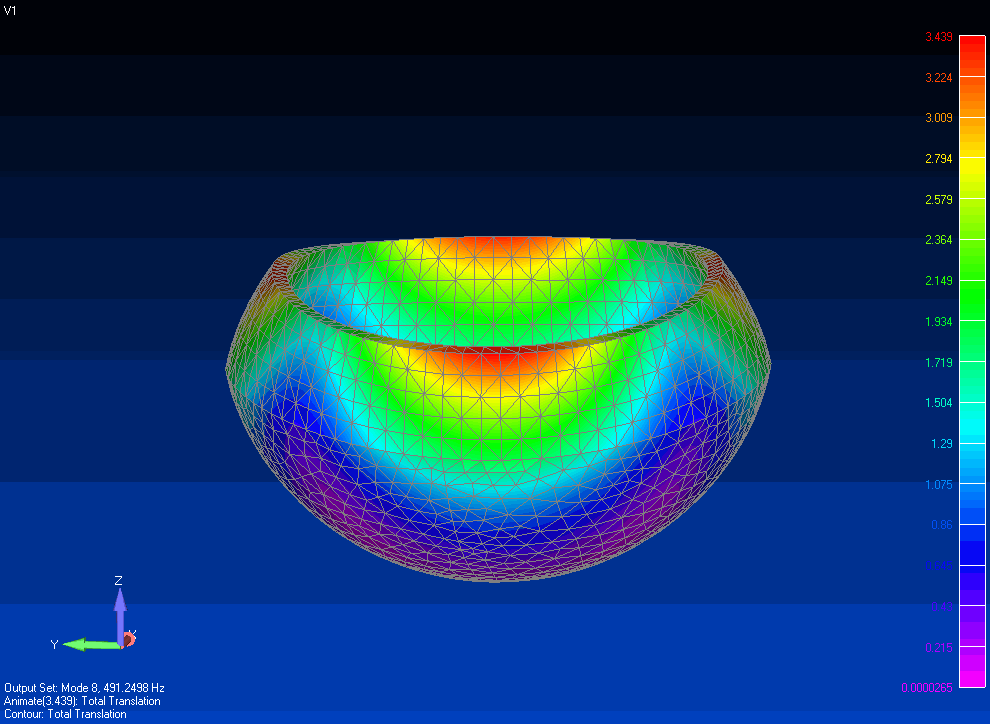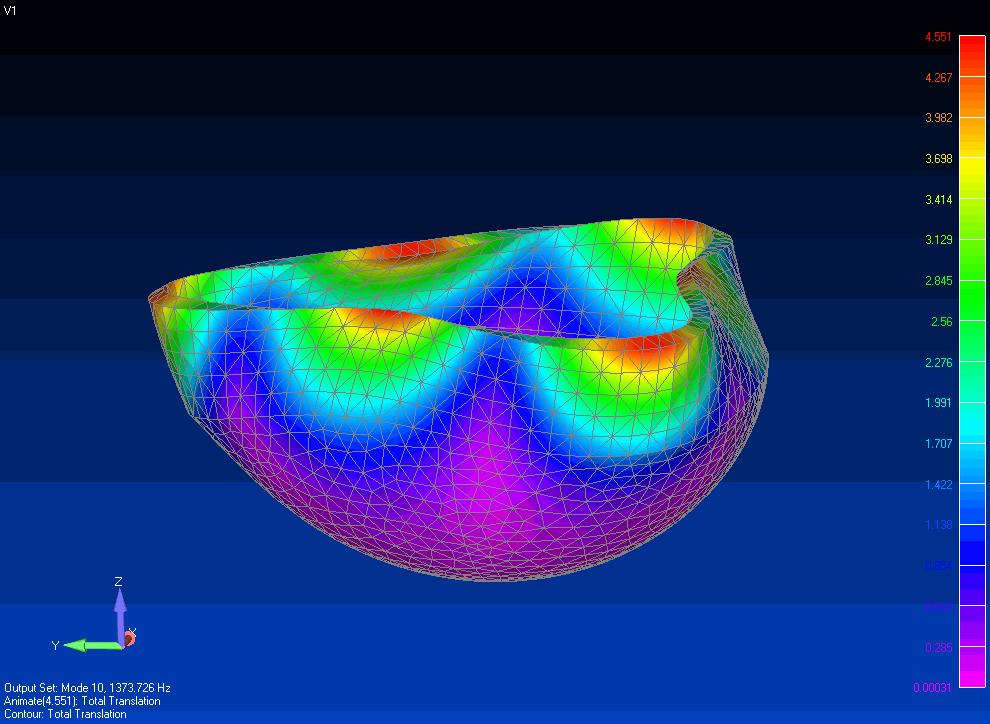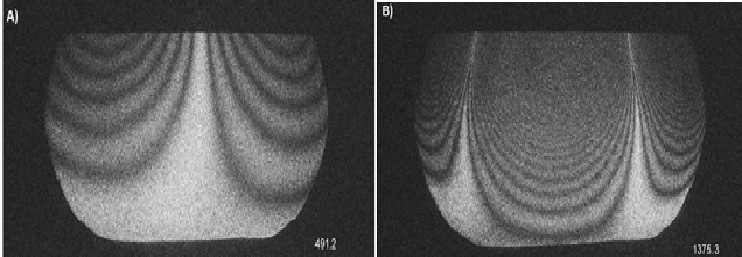

Brandon August - baugust@rollins.edu
Aditya Mahara - amahara@rollins.edu
Thomas Moore - tmoore@rollins.edu
Rollins College
1000 Holt Avenue
Winter Park, FL 32789
Popular version of paper 2pMU4
Presented Tuesday afternoon, May 15, 2012
163rd ASA Meeting, Hong Kong
The Himalayan singing bowl, sometimes referred to as the Tibetan singing bowl, originated around 500 BCE in the Tibetan Culture. Singing bowls are primarily made of brass with a mixture of other metals, which are hammered into a nearly symmetrical hemispherical shell and then hand-turned on a lathe. A typical example of a singing bowl from modern day Nepal is shown in Figure 1. Throughout the ages these bowls have been primarily used for spiritual, meditative and religious purposes, but recently they have also been used in contemporary new-age music and musical therapy.

Fig. 1. The Himalayan singing bowl used for our experiments. The puja can be seen inside of the bowl.
The bowl is made to sing by rubbing the bowl with a cylindrical wooden stick covered with felt or leather called a puja. When it is rubbed with the puja, the bowl produces an ethereal sound, an example of which can be heard here (insert audio file 1). It is this sound that makes the bowl unique and interesting to both musicians and physicists.
The singing bowl is an idiophone, which is an instrument that produces sound primarily by physical vibrations of the actual instrument. The size, shape and composition of the bowl determine the characteristics of the sound, and as with all musical instruments, the complexity of the sound is determined by how many different frequencies of vibration are simultaneously present. If only one frequency is allowed to vibrate the sound is often referred to as a pure tone; if multiple frequencies are present the sound is said to be complex. When the bowl is made to sing, the sound is almost a pure tone that is modulated so that it slowly rises and falls in intensity as the puja moves around the bowl.
 |
 |
Fig. 2. Simulation of the first two modes of vibration of a singing bowl. |
|
 |
Fig. 3 Electronic speckle pattern image of the singing bowl vibrating in the same modes shown in the simulation found in Figure 2. |
All vibrating objects can be characterized by patterns of vibration called modes that occur only at specific frequencies. These modes include regions that vibrate, referred to as antinodes, and regions that do not vibrate, referred to as nodes. The simulation shown in Figure 2 shows two such modes of a singing bowl. The fact that this motion actually occurs can be verified by imaging the vibrations using a technique known as electronic speckle pattern interferometry, which produces a contour map of the motion of a surface. Interferograms of the bowl are shown in Figure 3, which indicate that the motion is identical to the simulation. Only the first two patterns are shown in the figures, but there are an infinite number of them, each one with two more nodes and vibrating at a higher frequency than the previous one.
In most vibrating objects many of these patterns occur simultaneously. When the singing bowl is struck with the puja, three patterns usually vibrate at once. Since there are several of these simple patterns overlapping at the same time, the resulting motion is very complex; so is the sound. When the bowl is rubbed with the puja, however, only one of these patterns is formed. That is, all other patterns are eliminated and only this single pattern remains. This pattern is the one shown in the left panel in Figures 2 and 3. Thus the sound contains only one pitch and sounds like a pure tone. The only thing that keeps the sound from being perfectly pure is the fact that it changes volume as the puja moves around the bowl. For every rotation of the puja the sound gets loud and quiet four times. This modulation in intensity of the sound can be heard in the attached sound file.
The goal of the work reported here was to understand why the bowl sounds as it does. That is, why is there only one frequency of vibration and why is it modulated as the puja moves around the bowl? The answer to both of these questions can be found if one understands the motion of the puja during play.
When the puja is rubbed around the rim of the bowl the material covering the puja alternately sticks to the bowl and then slips in a series of short bursts of motion. The distance that the puja slips between the sticking points is typically about the same as the diameter of a human hair, so while the motion may appear smooth it is not. This stick-slip motion of the puja on the bowl produces vibrations in the bowl, which are responsible for creating the sound.
Investigation of the sound shows that the changes in volume occur because the pattern of vibration moves around the bowl with the puja. Since there is only one pattern, the sound gets loud when the vibrating part of the bowl is pointed toward the listener and quiet when the non-vibrating part is. Because the pattern has four separate vibrating areas, the sound intensity increases and decreases four times for every rotation of the puja.
The remaining question is, why is there only one pattern of vibration when the bowl is rubbed and not a complex set of patterns as occurs when the bowl is struck? It appears that the answer to this question can be found in the size and covering of the puja. The leather or felt covering of the puja tends to effectively damp vibrations of the bowl, which should not matter if the puja is always on a non-moving part of the bowl as claimed above. However, the contact with the puja actually extends past the nodal line into the part of the bowl that is vibrating because it has a relatively large diameter. This tends to damp vibrations a little. Since the more complex patterns have less space between the areas of maximum vibration, they are damped more heavily than the more simple patterns. This indicates that if you wish to hear more than a simple tone from the bowl you should use a smaller diameter puja with no covering. This is indeed the case, however, it is not the normal method of playing the bowl.
The physics describing the Himalayan singing bowl is very similar to that of many other systems. Some of those systems produce sounds as beautiful as the singing bowl, such as rubbing a finger around a wine glass or Benjamin Franklin's glass armonica. However, the sound of brakes squealing is also due to the same process. So the next time you are annoyed by squealing brakes, take comfort in knowing that we get the sonorous sounds of the singing bowl from the same process.